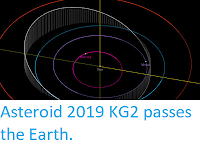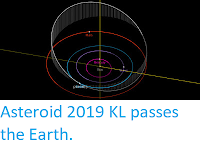Asteroid (441987) 2010 NY65 passed by the Earth at a distance of about 2 934 000
km (7.64 times the average distance between the Earth and the Moon, or 1.96% of the distance between the Earth and the Sun), slightly before 5.00 pm
GMT on Monday 24 June 2019. There was no danger of
the asteroid hitting us, though were it to do so it would have
presented a significant threat. (441987) 2010 NY65 has an estimated
equivalent
diameter of 94-300 m (i.e. it is estimated that a spherical object
with
the same volume would be 94-300 m in diameter), and an object at the
upper end of this range would be predicted to be capable of
passing through the Earth's
atmosphere relatively intact, impacting the ground directly with an
explosion that would be about 69 000 times as powerful as the
Hiroshima
bomb. Such an impact would result in an impact crater over 4.5 km
in
diameter
and devastation on a global scale, as well as climatic effects that
would last years or even decades.
The calculated orbit of (441987) 2010 NY65. JPL Small Body Database.
(441987) 2010 NY65 was discovered on 14 July 2010 by the Wide-field Infrared Survey Explorer
satellite. The designation 2010 NY65
implies that the asteroid was the 1584th object (asteroid Y65 -
in numbering asteroids the letters A-Y, excluding I, are assigned
numbers from 1 to 24, with a number added to the end each time the
alphabet is ended, so that A = 1, A1 = 25, A2 = 49, etc., which means that Y65 = 24 + (24 X 65) = 1584) discovered in the first half of July 2010 (period 2010 N), while the longer designation (441987) indicates that it was the 441 987th asteroid discovered
overall (asteroids are not given this longer designation immediately, to
ensure that numbered objects are genuine asteroids that have not been
previously described).
(441987) 2010 NY65 has a 364 day orbital period, with an elliptical orbit tilted at
an angle of 11.7° to the plain of the Solar System which takes in to
0.62 AU from the Sun (62% of the distance at which the Earth orbits the
Sun, and slightly less than the distance at which Venus orbits the Sun) and out to
1.36 AU (36%
further away from the Sun than the Earth). This means that close
encounters between the asteroid and Earth are fairly common, with the
last thought to have happened in June lat year (2018) and the next predicted
in June next year (2020). Although it does cross the Earth's
orbit and is briefly
further from the Sun on each cycle, 2019 EW1
spends most of its time
closer to the Sun than we are, and is therefore classified as an Aten
Group Asteroid. This also means that the asteroid has occasional close
encounters with the planet Venus, with the last calculated to have
occurred in March 2007, and the next predicted for May next year. As an asteroid probably larger than 150 m in diameter
that occasionally comes within 0.05 AU of the Earth, (441987) 2010 NY65 is also
classified as a Potentially Hazardous Asteroid.
See also...
Follow Sciency Thoughts on Facebook.







